Washer is Leaking: What to Do
In this comprehensive guide, we'll address the common household dilemma: a leaking washer. Whether it's a slow drip or a sudden gush, a leaking washer can be a cause of frustration and concern for homeowners. But fear not! We've compiled a detailed plan of action to help you troubleshoot and resolve this issue efficiently. From identifying the source of the leak to implementing effective solutions, we've got you covered every step of the way.
Understanding the Problem
Identifying the Type of Leak
Understanding the different types of washer leaks is crucial for effective troubleshooting. From leaks during the wash cycle to those occurring when the machine is idle, each type may point to specific underlying issues.
Common Causes of Washer Leaks
Explore the various reasons why your washer might be leaking, from worn-out hoses and faulty seals to clogged drains and overloading. Understanding the root cause is essential for implementing targeted solutions.
Potential Water Damage
Highlight the potential consequences of ignoring a leaking washer, including water damage to floors, walls, and surrounding fixtures. Emphasize the importance of prompt action to prevent costly repairs down the line.
Diagnosing the Issue
Inspecting the Washer
Provide a detailed guide on how to conduct a thorough visual inspection of the washer, focusing on key components such as hoses, seals, and drainage systems. Encourage readers to look for signs of wear, corrosion, and debris accumulation.
Performing a Leak Test
Walk readers through the process of conducting a leak test to pinpoint the exact source of the problem. Emphasize the importance of safety precautions and methodical observation during the testing process.
Using Diagnostic Tools
Introduce readers to various diagnostic tools and techniques, such as pressure gauges and infrared thermometers, to aid in leak detection. Highlight the benefits of these tools in identifying hidden or elusive leaks.
Taking Action
Repairing Common Issues
Provide step-by-step instructions for addressing common causes of washer leaks, such as replacing worn-out hoses, tightening loose fittings, and cleaning clogged drains. Include helpful tips and tricks for DIY repairs.
Seeking Professional Help
Acknowledge that some washer leaks may require the expertise of a professional plumber or appliance repair technician. Offer guidance on selecting reputable service providers and preparing for service appointments.
Preventive Maintenance Tips
Empower readers with preventive maintenance strategies to minimize the risk of future leaks, such as regular inspections, cleaning routines, and proper load management. Stress the importance of proactive care for prolonging the lifespan of their washer.
FAQs (Frequently Asked Questions)
What should I do if water is pooling around my washer?
If water is pooling around your washer, it's essential to first shut off the power and water supply to prevent further damage. Then, carefully inspect the washer for signs of leaks and address any identified issues promptly.
How can I tell if my washer's hoses need to be replaced?
Inspect the hoses for signs of wear, such as cracks, bulges, or fraying. Additionally, check for evidence of water stains or rust around the hose connections. If any abnormalities are detected, it's advisable to replace the hoses as a precautionary measure.
Is it safe to use my washer if it's leaking?
Using a leaking washer can pose safety hazards and exacerbate water damage. It's best to refrain from using the washer until the source of the leak has been identified and resolved. Continued use may lead to further damage and costly repairs.
Can a leaking washer cause mold growth?
Yes, a leaking washer can create a conducive environment for mold growth, especially if the area remains damp or poorly ventilated. To prevent mold and mildew formation, address washer leaks promptly and ensure thorough drying of affected surfaces.
Should I attempt to repair the washer myself?
DIY repairs can be appropriate for minor issues such as loose fittings or clogged drains. However, complex problems or those involving electrical components should be left to trained professionals to avoid injury or further damage to the appliance.
What steps can I take to prevent washer leaks in the future?
To prevent washer leaks, adopt a proactive approach to maintenance, including regular inspections, cleaning of filters and drains, and proper load balancing. Additionally, consider investing in high-quality hoses and fittings for added durability.
Conclusion
In conclusion, dealing with a leaking washer can be a daunting task, but armed with the right knowledge and resources, you can tackle the problem effectively. By following the steps outlined in this guide, you'll be well-equipped to identify, diagnose, and address washer leaks with confidence. Remember to prioritize safety, thoroughness, and preventive maintenance to keep your washer running smoothly for years to come.


